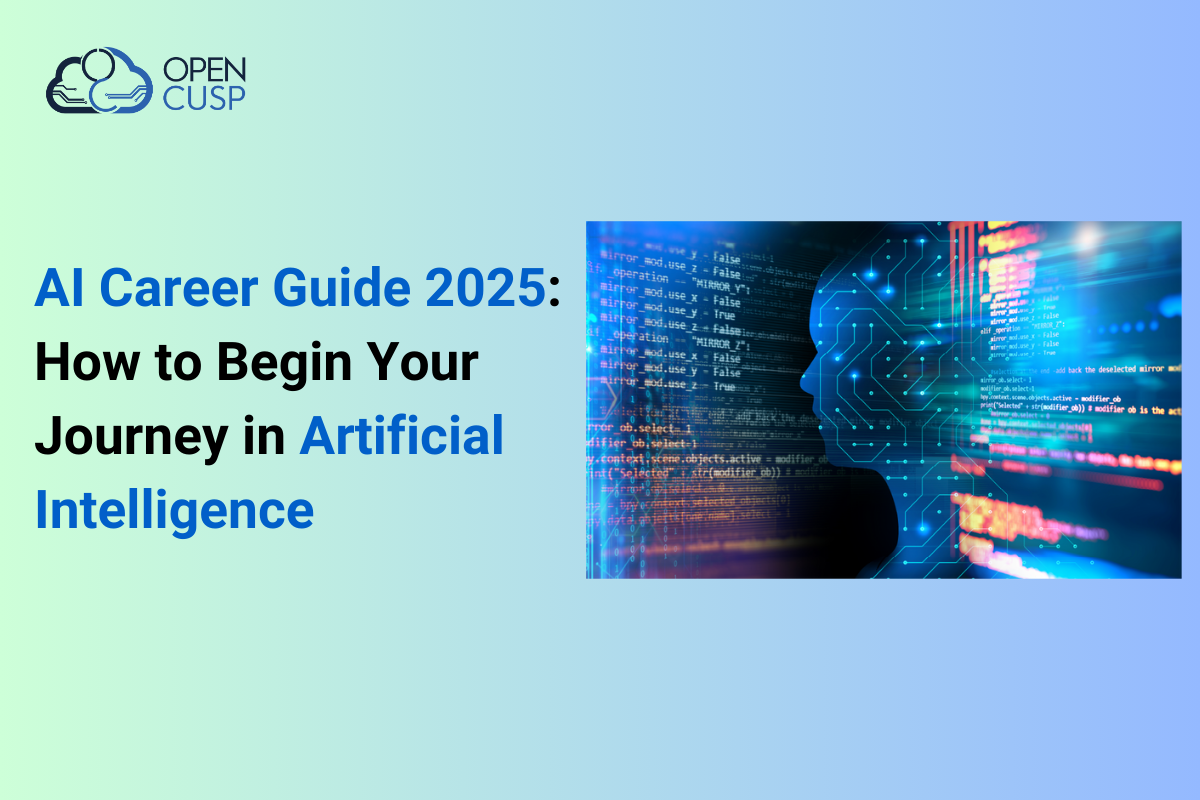AI Career Guide 2025: How to Begin Your Journey in Artificial Intelligence
Today Artificial Intelligence (AI) is transforming many industries from education, finance, retail, oil and gas to e-Commerce. If you look closely around the world, Artificial Intelligence (AI) has already become a part of our life. Some of the known examples are YouTube recommendation system, Alexa and self-driving Cars.
If someone wants to learn and make their career in this field, then today is the right time to learn AI online and grab multiple opportunities in the AI field.
I always tell all the learners that with the right Online AI training and correct guidance, you can also learn AI from scratch and can make your successful career in this field.
In this post, we will discuss everything from the start like Machine Learning (ML), Deep Learning (DL), Natural Language Processing (NLP) and Generative AI (Gen AI). If you want to start freelancing, get a highly paid job or want to start your own business in this field, then this step-by-step guide will help you like a true mentor who has already worked in Artificial Intelligence (AI) field for many years.
Let us start and learn how you can make your career in this exciting field.
AI Demand and Applications: Why AI Skills Are in High Demand
AI Professionals are in high demand these days and it will continue to rise in the coming years as well. As per the industry research, the AI Market will reach $407B by 2027. These days all major companies (Google, Microsoft, Netflix, OpenAI, Accenture, Facebook and many more) are hiring AI experts to automate operations, develop new smart products and for research work so that they can have a competitive advantage in the market.
There is no doubt AI is transforming many industries (these days) at a very fast speed.
Healthcare:
This industry is using Artificial Intelligence in many ways like early disease detection and personalized medicine.
Finance:
There are many use cases where Artificial Intelligence is transforming this industry like fraud detection, algorithmic trading.
Retail:
This industry is taking a big benefit of Artificial Intelligence. Some of the major companies are already using it for optimizing the supply chain network, inventory optimization and personalized product recommendation.
Education:
The Education industry is using AI to give students a personalized learning experience.
Recently the World Economic Forum has predicted that there will be 97 million new AI jobs created worldwide by 2027.
Roles like ML Engineer, AI Researcher, NLP Specialist and Gen AI Engineer would remain in high demand and anyone can make a highly paid career (with a smart strategy and learn AI online) in this field.
You can also future-proof your career in this field if you start learning AI today.
STEP 1 - Building the Right Foundation
Success in AI, firstly, you should build a strong foundation: At Open Cusp, we always focus on 3 basic (but critical) topics: Mathematics, Programming and Problem-Solving skills – Let us discuss these one by one.
Mathematics For AI:
AI is heavily dependent on Mathematics. Some of the important topics are:
• Linear Algebra
• Calculus
• Probability
• Statistics
In addition to this, there are also other critical topics like Vectors, derivatives, probability distributions and matrices that basically help you to understand in a clear way how AI models make decisions.
Programming Basics:
If you want to be an expert in AI, then one must learn Python language. It is very simple to learn and has very powerful libraries like NumPy, Pandas and Matplotlib.
In addition to this, students should also focus on learning basic topics:
• Data Types and Variables
• Loops and Functions
• Different Data Structures
• Object-Oriented Programming Basics
Problem Solving Mindset:
I always tell my students that you will not get success in this field just by learning coding. You should also be able to solve real-world problems by building smart AI solutions. In order to do so, it becomes very important to develop critical thinking and analytical skills. By doing so, you would be able to design intelligent solutions and create actual value for your client.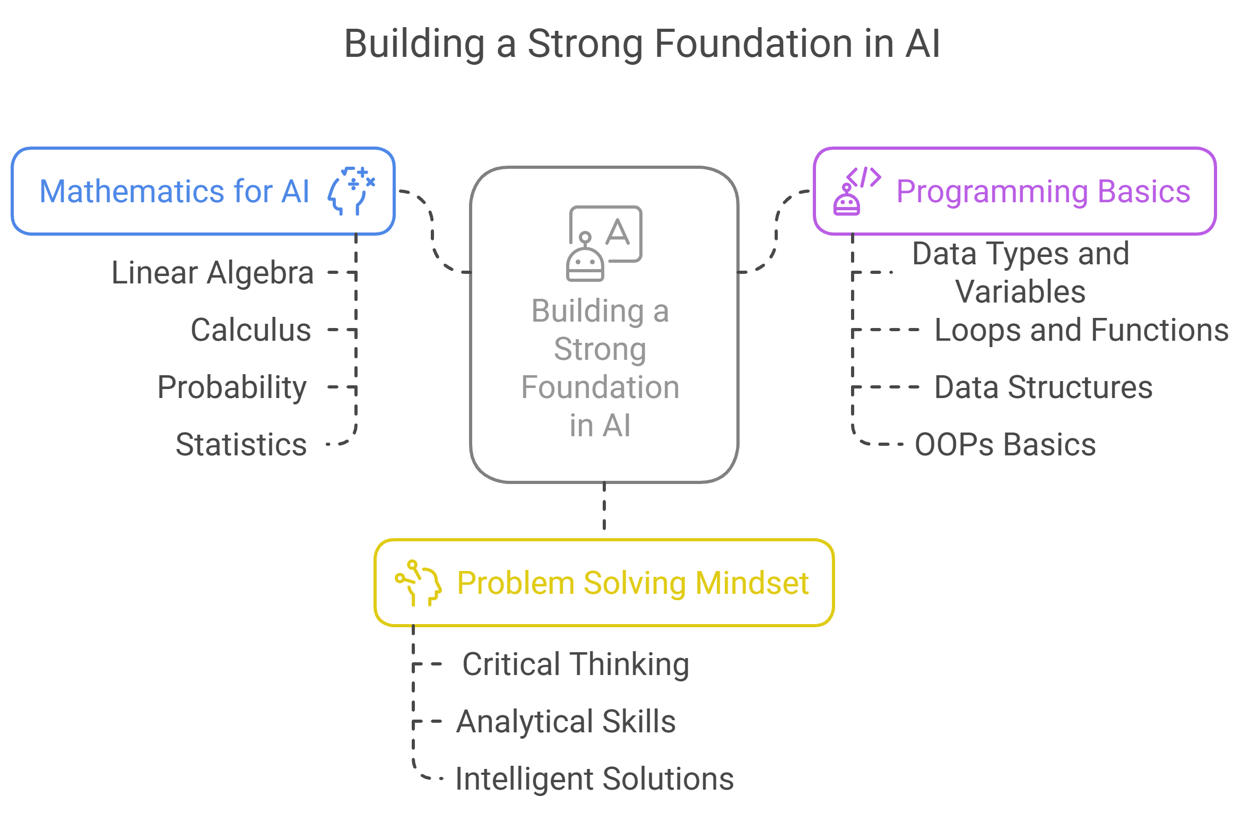
Steps to Start
• Search for a genuine training institute who has real industry experience.
• Enroll for an online AI course that teaches from basics like Python, Mathematics for AI.
• On a daily basis start practicing Mathematics and Coding problems for 60 to 90 minutes.
• At this stage, you should start making small projects that would help you to build your confidence.
Please note that if you build your foundation strong, then your AI learning journey will be fast and smooth.
STEP 2 - Machine Learning (ML)
It is the backbone of Artificial Intelligence (AI). In this, a machine learns from the data that is given as an input and is able to make intelligent decisions without explicit programming.
In other words, you can also think of Machine Learning (ML) as the heart of AI.
Related article: How to Learn Machine Learning Online (2025): Step-by-Step Beginner’s Guide
Types of Machine Learning
Supervised Learning:
In this, you give the machine both input and output data.
For Example: You show a machine many house details (Input Data) with their prices (Output Data). After training completion, the machine starts predicting the new house price (based on the data it was trained on).
Unsupervised Learning:
In this we don’t give any output variable or answer (during training time). Only input data is provided to the machine for training purposes. The machine needs to figure out the output on its own.
For Example: In the e-Commerce industry, a machine takes an input (like customer sales data) and based on this it groups similar types of customers together (like old customers, new customers).
Reinforcement Learning:
In this a machine learns by trial-and-error method. If a machine does a good job, then it is rewarded with points, otherwise a penalty is charged for doing a bad job.
For Example: Suppose you are teaching a robot machine how to walk. If it walks in the right way, then it gets points. Otherwise, it is penalized (by deducting points).
Machine Learning Algorithms
• Linear Regression (A straight line that best fits the data)
• Logistic Regression (It predicts Yes or No)
• Decision Trees (It makes decisions like a flowchart)
• Random Forest (It is like many decision trees that work together for better results)
• K-nearest Neighbor (It searches things closest to each other)
• Support Vector Machine (SVM): It draws the best line between two groups of data
Tools to Start Learning Machine Learning (ML) Online
Scikit-learn:
It is a simple Python library that helps you build ML models easily.
Google Colab:
It is a free cloud environment where you can write and run your Python code. You don’t need to install anything on your computer.
Pandas and Matplotlib:
The first one help you in two ways: to organize and explore your data. If you want to make beautiful charts, then you can use Matplotlib.
Beginners Project Idea
Students can start their project journey by making a simple house price prediction model that will use supervised learning.
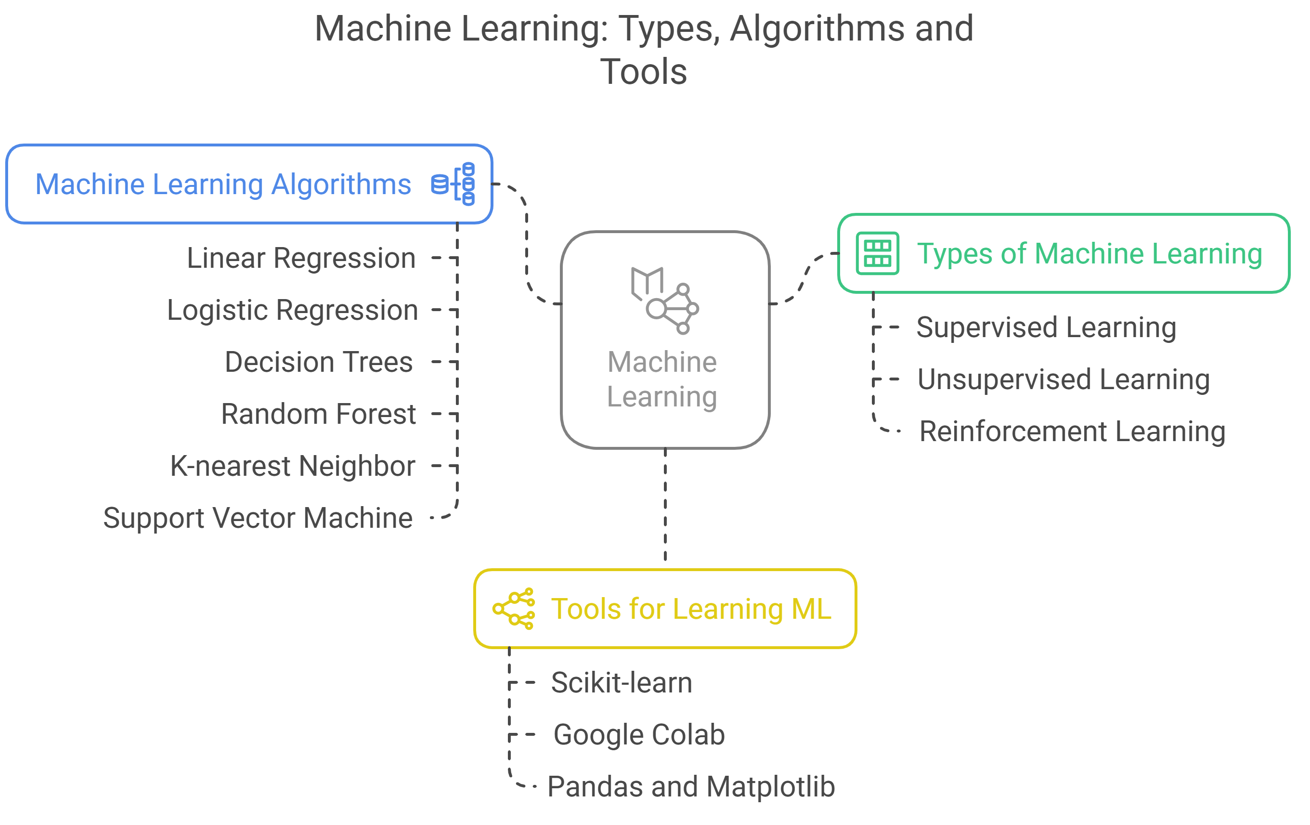
STEP 3 - Deep Dive into Deep Learning
It is a subset of Machine Learning (ML) where machines learn using neural networks.
Please note that deep learning is inspired by the human brain.
In simple words, in deep learning, a machine learns like a human brain understands how we recognize real faces, understand sounds etc.
Few Examples of Deep Learning (DL) are:
• It is used for image recognition.
• It is also used for playing games like chess.
• For speech recognition (For example – a machine can listen to a voice and convert it into text).
For all these tasks, deep learning plays a very important role.
Please note that deep learning is used only when the problem is very complex like:
• You have lots of data (like millions of images, videos and audio files).
• You need high accuracy.
• Features are difficult to design by hand.
• If you need to work with unstructured data (like images, videos and natural language)
Some Famous Deep Learning Models (DLM)
Convolutional Neural Network (CNN):
This model is used for recognizing images and videos.
The CNN model is very good at identifying patterns like shapes, colors and objects in images and videos.
Recurrent Neural Network (RNN):
This model is good for sequences like:
• Time Series (Like stock prices day by day)
• Text (Words in a sentence)
The good thing about RNN models is they remember information from the last step while processing the current step.
Autoencoders:
It is used for compressing the data (making it small in size) or removing noise (like fixing blurry photos).
Some Tools for Deep Learning (DL)
TensorFlow:
It is an open-source platform that helps you to build, train and deploy (in production) deep learning models. The good thing is anyone can use this tool free of cost.
Keras:
This is a very simple tool which is built on top of TensorFlow. Using Keras, you can write complex code in very few lines and in an easy way. This tool is good for beginner-level learners.
PyTorch:
This tool is developed by Facebook (Meta) and it is famous among students and researchers. If you want to research or try new ideas by experimenting, then PyTorch is the best tool to try out.
Deep Learning Project
You can start building a deep learning model to classify different objects like Cats vs Dogs.
The objective is to make this project successful and learn as much as possible, So that this learning could be applied to a real-time project in a company.
This project will help you to learn 3 important things:
• How an image is preprocessed
• Data augmentation (It helps the model to learn better, not overfit)
• How the model is evaluated (to test the model on new images)
If you choose the right online AI course (for beginners), then you can learn deep learning in a fun and simple way.
In addition to this, you can also build real-world applications under expert guidance and supervision.
STEP 4 - Understanding NLP
This is a subset of deep learning and it helps computers to perform 3 important tasks:
• Read a language.
• Understand a language.
• Generate a response in a language.
The first example of NLP is Siri or Alexa. It understands your voice using Natural Language Processing (NLP) and gives you a response accordingly.
When you Google translate a piece of content from one language to another, it uses NLP.
Modern Breakthrough in NLP
Transformers:
This model is very good at understanding the word relationship even for long sentences as well. Due to this feature, it is better than old architectures.
For Example – A word “Apple” can have two meanings (a fruit or a company). This model can understand it even in a long sentence as well.
BERT (Bidirectional Encoder Representation from Transformers):
This model can read texts from both directions (from left to right and right to left). In this way, the BERT model can understand the true meaning of a word.
For Example – If you enter an input as
“The bank was flooded after the storm”,
The BERT model will understand that here you are talking about a river’s bank (not a financial bank).
Applications of NLP
Sentiment Analysis:
It is used to find out if someone is happy, sad or angry.
Chatbot:
It can process your input text information and answer automatically.
Text Summary:
It can convert a long passage into a small summary.
Language Translation:
It can translate texts from one language to another (from Hindi to English)
Important NLP Libraries
If you start working on an NLP project, then the below-mentioned NLP libraries will be helpful:
SpaCy:
This library is fast and easy to use. It is used in performing 3 important tasks:
• Tokenization: It is used to break a sentence into words.
• Part of Speech Tagging: It can find the role of each word (like noun, verb, adjective etc.) in a sentence.
• Parsing: It helps to understand the structure of a sentence (like who did what etc.)
Hugging Face Transformers:
This library gives you ready-made models like BERT, GPT etc.
Using this, you can fine-tune on your tasks (for your sentence analyzer or you can use it to develop a chatbot).
The good thing is you can directly use it by writing a few lines of code and it can save you months of time.
NLP Project
At this stage, you can build a “Movie Review Sentiment Analyzer” project to predict if a movie has positive or negative sentiments.
After working on these types of projects, a student will be able to gain real NLP skills that are in high demand.
Companies like to hire those candidates who have experience in building chatbots to analyze customer feedback etc.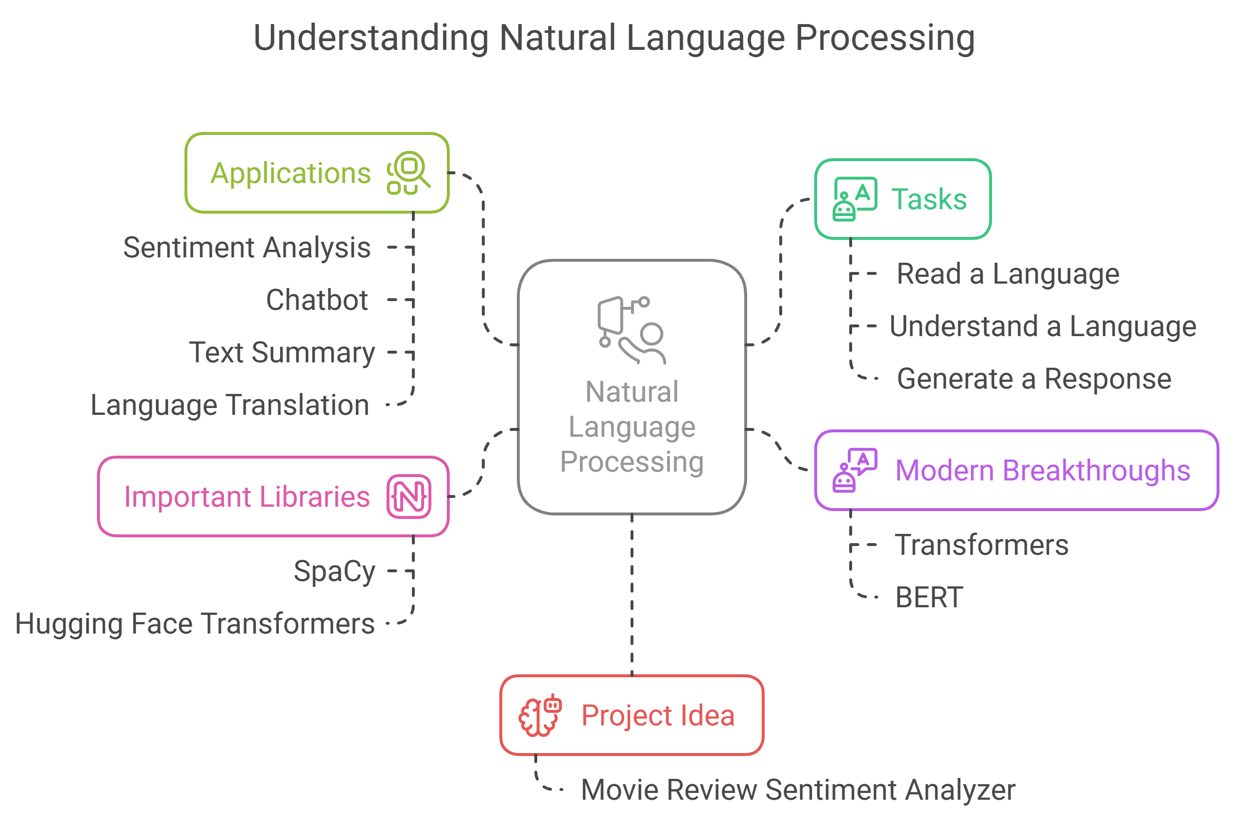
STEP 5 - Generative AI (Gen AI)
In today’s time, everyone is talking about Gen AI and it is a fast-growing field of AI.
• It doesn’t only analyze your data but can also do multiple things
• It can help with writing text jobs (generating new content, summary, meaningful extracts)
• It can create new images to help in daily tasks
• It can generate music and even videos
• It can also help in writing code to help developers
Examples:
• ChatGPT can write texts as per user’s instructions
• DALL·E can generate new images based on input texts
• GitHub Copilot is used to write code to help programmers in their daily tasks
Types of Generative AI Models
Generative Adversarial Network (GAN):
This model is used to create new realistic images, videos; it is widely used in many areas like art, gaming, entertainment, AI model training, and to create deep fakes.
Variational Autoencoders (VAEs):
This model is very smart in learning the essence of something and can create a totally new (but different) version of it.
For Example: You can train this model using thousands of dog pictures and it can observe and note down the hidden patterns (common shapes, colors and sizes).
After training completion, it can create a new dog image which is totally different from existing ones.
Transformers Based Models:
These models can generate text like a human does and we can use them for generating high-quality code for developers.
In addition to this, there are many more applications where these models can be used.
List of Tools
Hugging Face Transformers:
This library has ready-to-use models like GPT-2, GPT-3 etc. that can generate texts.
The good thing about this library is you can easily train, fine-tune and use AI models that can generate texts for you.
Diffusion Models:
If you want to create realistic images, then you can use this tool.
For Example: If a user enters a prompt
“A person eating in mountains with a tiger,”
Then AI will draw a real image for this prompt.
First Gen AI Project Idea
A student can create a GPT-2 model to write summaries for long product descriptions. This project is good to start because a student can learn how to customize the AI model and they can also build their own content generator that can be used for blogs, marketing purposes.
STEP 6 - Essential Tools and Platforms to Practice AI Skills
There are multiple tools available that will help you to master AI. By using these tools, you can build, test and improve your models. This is the reason why every AI beginner should focus on practicing on a daily basis.
List of Tools for Learning AI Online
Google Colab:
It is a free online tool. By using this tool, you can write and run your Python code. You only need to just open your browser and you can start writing your code.
Jupyter Notebook:
This tool allows you to write your code and notes side by side.
Kaggle:
It is a website where you can perform 3 important tasks:
• It gives you access to free datasets to practice Machine Learning.
• You get an opportunity to work on real-life problems.
• You can also join a community and share your work. This will give you a chance to learn from others.
Daily Practice:
• You should daily practice for at least 60–90 minutes.
• You should target to first complete small projects on a weekly basis.
• One should always clear their doubts from mentors or teachers.
• You should also follow blogs and newsletters.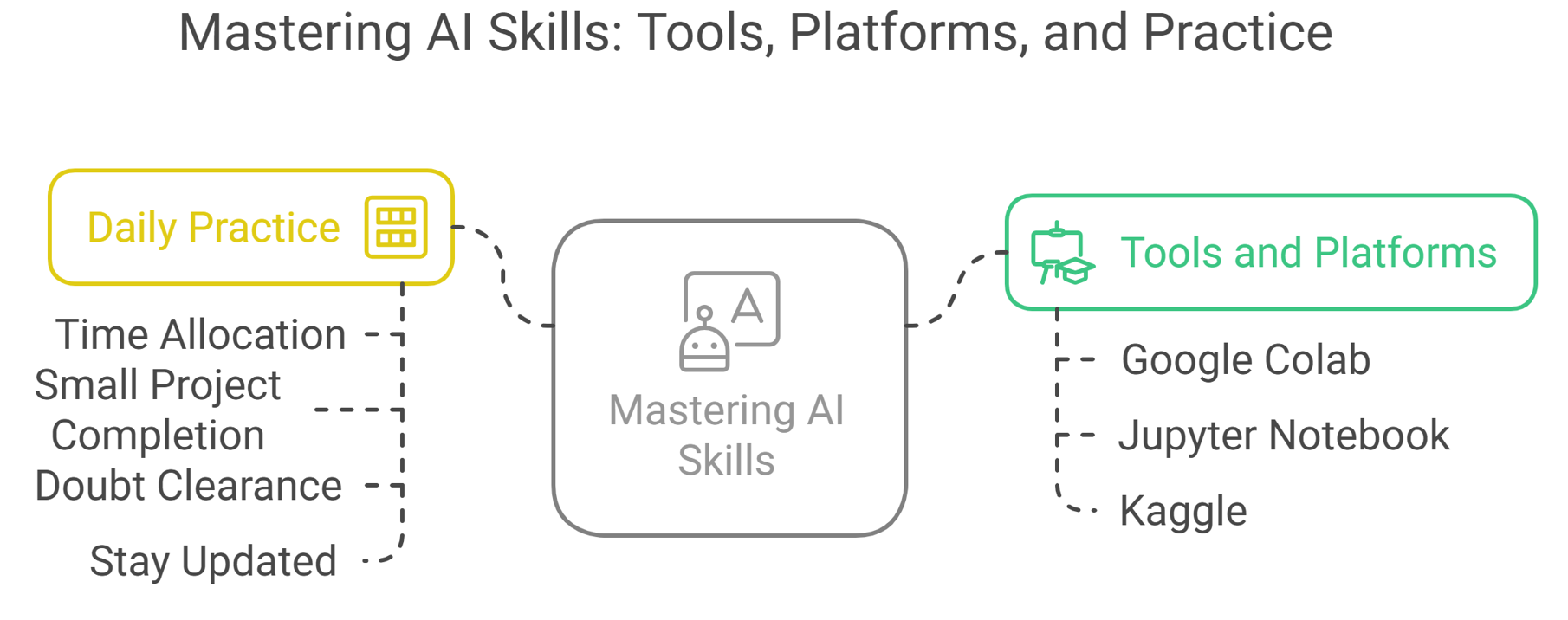
STEP 7 - Projects to Build Your AI Portfolio
Recruiters from big companies always look for good projects in your resume. So it is essential to have a strong portfolio of projects that prove you have real-time experience in this field.
Project Ideas or Beginners:
• Create a project for analyzing the sentiment of a movie.
• Using linear regression, predict the house prices.
Project Ideas for Intermediate Level:
• Find fake news articles using NLP.
• Build a customer service chatbot for the e-commerce industry.
Project Ideas for Advanced Level:
• Create a GAN model that can generate real human faces.
• Develop a recommendation system like YouTube or Netflix.
Good Practices to Follow
• You should always upload your project on GitHub.
• It is always good to have an AI certification in your resume.
• Start writing blogs mentioning the project details and the results achieved.
• Create a personal website showing your portfolio of projects so that your profile stands out from others.
Recruiters will start calling you if you have a professional-style portfolio along with real project experience. In addition to this, if you pass an AI certification, then it will boost your chances to get a good job as well.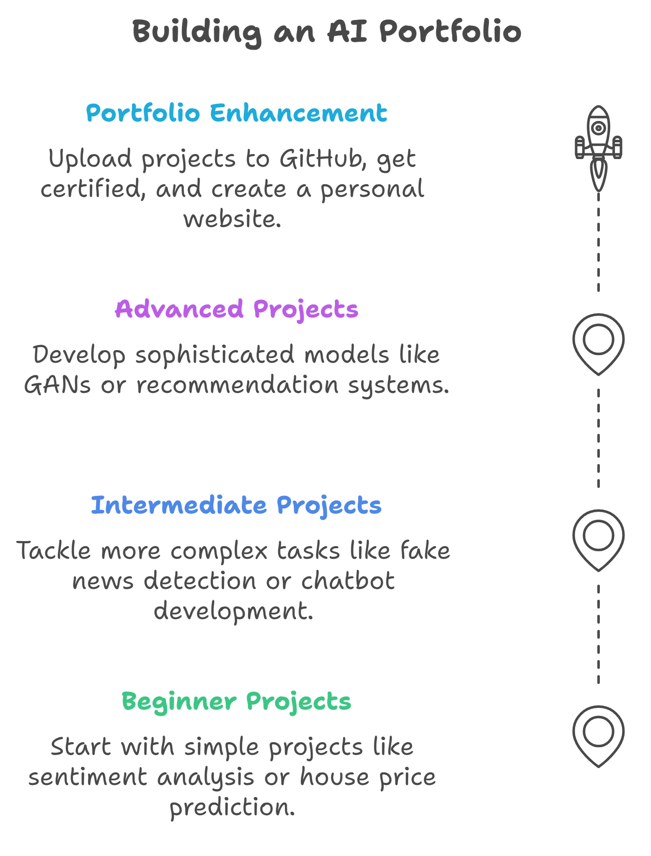
STEP 8 - Career Pathways After Learning AI
After completing an AI course, you should actively start applying for AI roles in good companies.
Famous Career Roles
Machine Learning Engineer:
In this role, you need to build predictive models and also deploy them into production servers.
Data Scientist:
In this role, you need to analyze complex datasets to find out useful business insights.
NLP Engineer:
This specialized role is to develop such applications that can understand human language(s).
Research Scientist:
In this role, you are expected to create new ideas, develop new models and find better ways to solve a particular problem.
AI Product Manager:
In this, a candidate needs to manage a complete AI project and define the overall roadmap as well.
Salary Expectations
• Beginner AI Engineers can earn between $100,000 - $120,000 annually.
• On the other side, senior AI specialists can earn good salaries ranging between $200,000 - $350,000, along with bonuses. Some companies also give company stock as well based on performance.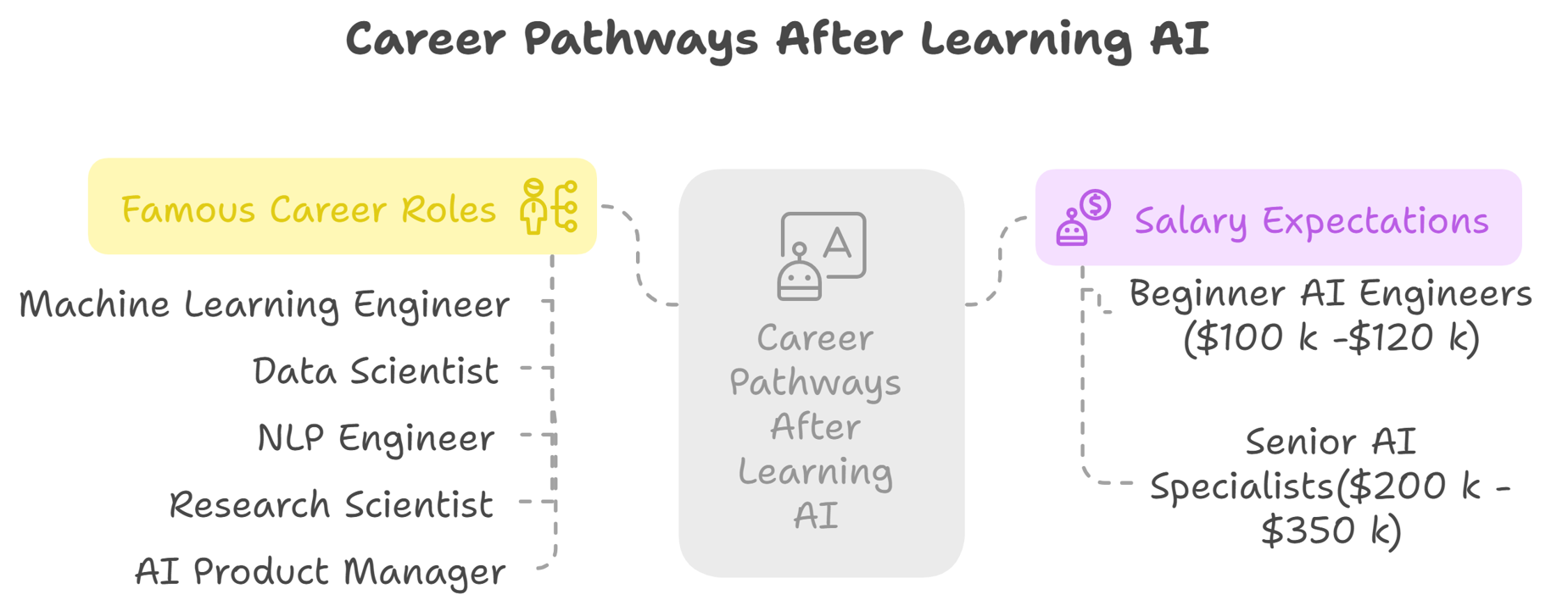
Conclusion
This is the best time to start your AI learning journey, as AI is already transforming many industries (like Healthcare, Finance, Retail and Oil and Gas etc.) in the market. As per the latest report by PWC, Artificial Intelligence is going to contribute $15.7 trillion to the global economy by 2030.
At the same time, demand for AI professionals is increasing on a daily basis. Last year (in 2024), there were over 400,000 AI jobs posted only on the LinkedIn platform!
Always remember that every AI expert once started their journey just like you.
Always follow these simple steps to achieve success in this field:
• Take expert guidance from the start.
• Spend some time on hands-on experience.
• Stay consistent with practice.
If you are looking for a secure and high-paying job, want to get promoted quickly, or want to start your own AI business, we can support you at each step in this journey.
Frequently Asked Questions (FAQs)
Is coding knowledge required to learn AI?
No. You can start your journey by first learning the Python language, which is easy and user-friendly. Spend a good amount of time to make your foundation strong. Once you are comfortable with coding, then you can start learning other AI modules.
How much time does it take to learn AI?
There is no direct answer to this. It totally depends on your background and understanding. But if you stay consistent, then you can learn it in 3 months as well.
What should I learn first – ML, DL, NLP, or Generative AI?
ML is the foundation, so always spend a good amount of time learning it. Once you are comfortable with ML, then you can start learning specialized paths like DL, NLP, or Generative AI based on your needs.
Is a degree required to get an AI job?
No, most companies look for AI skills, a list of projects, and practical experience. Your GitHub contributions and problem-solving skills are more important than a formal degree.
